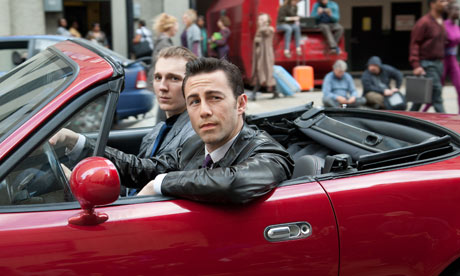In the new movie Looper, starring Joseph Gordon-Levitt and Bruce Willis, director Rian Johnson gives his audience a new look at a dark, dystopian future molded by social decay and organized crime. Cities are totally corrupt, controlled by mobsters and hitmen, and poverty and homelessness run rampant through the streets of not only Kansas City, where the film takes place, but the entire world.
The premise of the movie is explained bluntly during the opening credits of the film through Gordon-Levitt's narration. The present time is 2044, and although time travel hasn't been invented yet, it will be 30 years from now-in 2074. The practice is promptly made illegal by the government, but mobsters use it in order to send their enemies back to the past at a specific time and place where they can be quickly and quietly killed by hired hitmen known as "loopers." In order to avoid any "loose ends," the loopers are eventually forced to kill their future selves, which is known as "closing a loop." They are then given several bars of gold, and allowed to live theirs lives as they please until they are sent back to the past and shot by their younger selves. However, protagonist Joe (Gordon-Levitt) throws himself and his mafia-bosses for a loop (hehe) when his older self (Willis) manages to escape and avoid his murder. The film's plot revolves around young Joe's plight to capture and kill old Joe, and old Joe's equally desperate mission to save himself and his future wife.
The movie, while carried on its twisting, creative plot and excellent actors, would not be nearly as poignant without the background of its grimy, ruthless city. The city becomes like a character itself, and a most vicious one at that. Two of the most poignant scenes take place only about 10-15 minutes into the film, and revolve around the city's descent into a murky underworld. A quick shot shows a flat expanse of asphalt covered with scraggly looking people both standing around and sitting under makeshift tents. A line of people wait to board a bus, and a dirty man comes up and takes another man's belongings (two meaningless looking plastic bags) before sprinting away. When he realizes what has happened, the robbed man calmly takes a gun out of his pocket and shoots and kills the thief with an air of non-nonchalance. No one around reacts to what has happened-no one even looks up or pretends to care. This sort of raw violence is evidently an everyday occurrence in the city, and has molded its viewers into apathetic animals. In another scene, a drugged-up Joe drives his equally wasted friends around the dark city in his flashy sports car-killers and other men of violence are obviously very high in status in this reality. Tripping and with spotty vision, Joe stops his car just inches before running over a tiny, dirty, lost-looking little boy playing soccer in the street with his friends. A filthy white wife-beater hangs off of the boys' scrawny shoulders as a chorus of "shit, man!" and laughter come from Joe's friends and the boy stares silently into the eyes of the man who almost just killed him.
These two scenes and the countless other images of a lost and spiraling city really shaped the film into a bleak and harrowing gem. As Jay-Z raps in "Empire State of Mind," "cities is a pity/half of y'all won't make it"-in this film, the cities are more than just a pity, they breed killers, and unless people conform to that standard of violence, they too won't make it.



This is awesome! I love the connection between "Empire State of Mind," and Looper--two very different approaches to the city.
ReplyDeleteWhen I saw Looper, I thought it would be a great blog idea, and I'm so glad you used it, Katherine! I think it would be interesting to look at Looper and compare it to The Intuitionist, based off the ideas that you've introduced here. Love it!
ReplyDelete